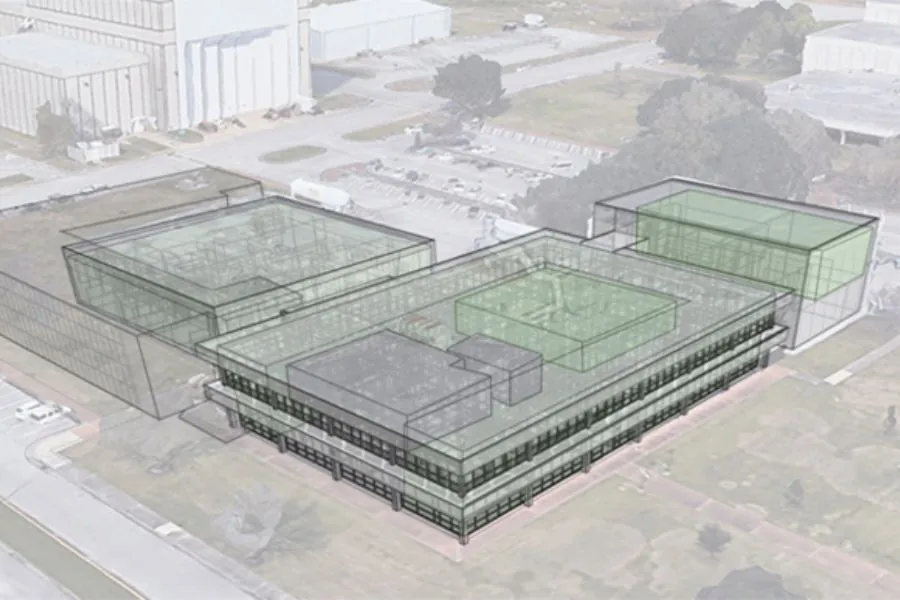RS&H Plans, Designs New NASA Labs for New Missions

NASA’s Astromaterials Research and Exploration Science (ARES) Division is the keeper of the agency’s extraterrestrial materials like lunar samples, stardust, meteorites and cosmic dust. In fact, the Building 31 North vault at Johnson Space Center in Houston stores 85 percent of material collected from the Moon.
Now, NASA is preparing for a new kind of collection – asteroid samples.
NASA’s Origins Spectral Interpretation Resource Identification Security-Regolith Explorer (OSIRIS-REx) spacecraft has traveled to a near-Earth asteroid called Bennu with the mission to bring samples back to Earth for study. The mission will help scientists investigate how planets formed and how life began, as well as improve our understanding of asteroids that could impact Earth.
OSIRIS-REx launched on Sept. 8, 2016, and is currently orbiting Bennu, detailing the rocky, bumpy surface amid a two-year survey of the asteroid. As planned, the spacecraft will return to Earth in 2023.
RS&H designed approximately 10,600 square feet within Building 31 to contain a new Asteroid Sample Curation cleanroom suite to house samples returning to earth from the OSIRIS-REx and Hayabusa 2 asteroid research missions. The space also includes an advanced cleaning suite as well as Mars research laboratories. These labs are currently under construction and will be online for the required two years before the asteroid study begins.
Facility Assessment Shows New Needs
The Building 31 Annex was born out of a facility assessment we performed for the ARES division.
Our team interviewed 14 ARES technical groups, examined and assessed the group’s nine currently occupied buildings on the JSC campus – many of which date back to the 1960s. We performed cost estimates and determined how to consolidate the current footprint into effective and efficient spaces suitable for advanced science.
In our assessment, we identified additional lab space needed to support the asteroid curation suite, as well as a need for more than 25,000 square feet of new lab and cleanroom capability. That led to the Building 31 Annex project.
With 14 groups to accommodate in the space, we had a big puzzle in front of us to arrange.
The Building 31 Annex process began with a full week of in-person programming charrettes in January. It was a full week of programming exercises, engaging various user groups to create bubble diagrams, site plans and conditions. We invested a lot of time really understanding what each group needs for their science missions, as well as their business requirements.
In our interviews and research, we discovered that, while there are organizations that have some of the capabilities as the ARES group, no other organization has the full suite of all these capabilities. The new Building 31 complex will be one of a kind, a one-stop shop for astromaterial analysis and research.
Design for Now and Later
When you are designing a new lab, you always want to keep in mind how the science may evolve and incorporate some flexibility in terms of building spaces and systems.
For NASA labs like these, future flexibility is paramount, as there are requirements for future studies that have not been determined yet. Flexibility lends itself to designs that can grow.
Cleanroom suites are sometimes a maze of boxes, but that layout is not conducive to future growth and flexibility. Instead, we’ve designed a cleanroom spine that can grow with a series of suites that can grow off it for use with more missions in the future.
Big-picture, expandable designs must also factor in considerations for all the mechanical and building systems. Even the doorways must be amendable. Because some equipment needs are still unknown, doors must be able to adjust to open 6 feet wide instead of 3.
Materials are also a hypersensitive issue. The ISO-5 cleanrooms cannot have anything inside them that could contaminate the mission science – once a sample is contaminated, it is neither usable nor replaceable.
Prohibited materials include anything magnetic, silicon sealants, paints, metal oxides, films, latex and nylons. After all, you can’t find latex on an asteroid – or on Mars. We’ve learned to focus on what materials can be used rather than what can’t be used, as that process makes it easier for the building contractors.
Building 31 Annex’s positioning to Building 31 creates more usable space for the existing high bay. The Building 31 high bay has long had problems getting too warm in the hot Texas sun. With the Annex designed on the front of the combined facility, the high bay’s heat load will be dramatically reduced, so the spaces inside will be useable year-round.
RS&H submitted the 30-percent design plans in June. Not only was the review conducted via an online meeting, but we also had six separate lab design reviews via online meetings prior to our submission.
Learn how RS&H’s aerospace services and laboratory design experts can help bring your next project to life.
